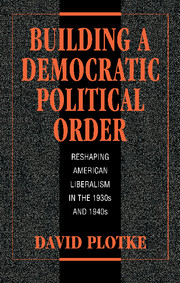Book contents
- Frontmatter
- Contents
- Preface
- Introduction: The Democratic order as a political project
- 1 When does politics change?
- 2 Creating political orders: the logic of the Democratic experience
- 3 Democratic opportunities in the crises of the 1930s
- 4 Passing the Wagner Act and building a new Democratic state
- 5 Party and movements in the Democratic upsurge, 1935–7
- 6 Progressive liberalism as pragmatic common sense
- 7 Surprising years: electing Truman and sustaining the Democratic order, 1947–9
- 8 Passing Taft-Hartley: what the losers won (and what the winners lost)
- 9 New political fronts? growth and civil rights in the 1940s
- 10 Democratic anti-Communism and the Cold War
- 11 From Truman to Kennedy: the reach and limits of Democratic power
- 12 Was the Democratic order democratic?
- Index
12 - Was the Democratic order democratic?
Published online by Cambridge University Press: 17 September 2009
- Frontmatter
- Contents
- Preface
- Introduction: The Democratic order as a political project
- 1 When does politics change?
- 2 Creating political orders: the logic of the Democratic experience
- 3 Democratic opportunities in the crises of the 1930s
- 4 Passing the Wagner Act and building a new Democratic state
- 5 Party and movements in the Democratic upsurge, 1935–7
- 6 Progressive liberalism as pragmatic common sense
- 7 Surprising years: electing Truman and sustaining the Democratic order, 1947–9
- 8 Passing Taft-Hartley: what the losers won (and what the winners lost)
- 9 New political fronts? growth and civil rights in the 1940s
- 10 Democratic anti-Communism and the Cold War
- 11 From Truman to Kennedy: the reach and limits of Democratic power
- 12 Was the Democratic order democratic?
- Index
Summary
The previous chapter returned to the main arguments about the course of political orders and the shape of the Democratic order presented in Chapter 2. This chapter considers the political meaning of that regime: In what sense was the Democratic order democratic? Its proponents claimed that label, but were they entitled to do so? I will assess the overall effects of the Democratic order, its relation to other imaginable regimes (notably social democratic regimes), and the character of Democratic political leadership.
The Democratic order and American political development
What were the political effects of the Democratic order? Its practical accomplishments included ending the Depression and winning World War II, both on democratic terms. A central feature of the Democratic order was its distinctive and powerful fusion of democratic and modernizing themes. Leaders of the Democratic order made persuasive arguments for a democratic expansion of interest-group organizations and political participation, as well as for government action to spur social and economic development. Their arguments succeeded, and their policies had broad effects that were mainly congruent with stated aims. That the Democratic order eventually ended means failure only if one wrongly imagines that regimes can be permanent in advanced market societies.
In the regime politics at the beginning of the Democratic order, fierce conflicts arose as competing forces tried to define the practical meaning of liberal, democratic, and progressive conceptions.
- Type
- Chapter
- Information
- Building a Democratic Political OrderReshaping American Liberalism in the 1930s and 1940s, pp. 359 - 380Publisher: Cambridge University PressPrint publication year: 1996

